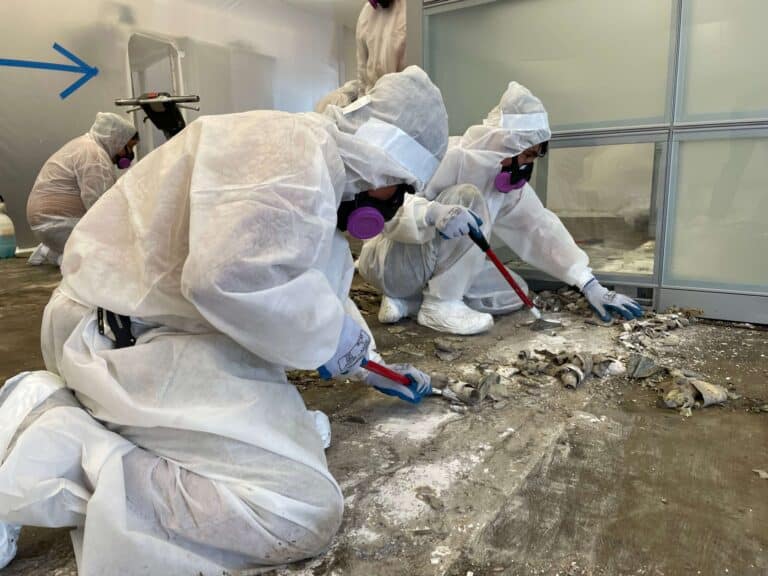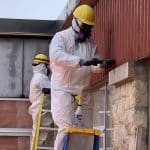Section 1: Understanding Asbestos
Transition: Before delving into the intricacies of asbestos services, it’s essential to have a comprehensive understanding of asbestos itself.
1.1 What is Asbestos?
Asbestos refers to a group of naturally occurring minerals that were widely used in construction and manufacturing due to their heat resistance and durability. These minerals consist of microscopic fibers that can easily become airborne when disturbed. Unfortunately, prolonged exposure to asbestos fibers can lead to serious health issues, including lung cancer, mesothelioma, and asbestosis. Despite its ban in many countries, asbestos still lingers in countless buildings and products, posing a persistent threat to public health.
1.2 The History of Asbestos Use
The history of asbestos dates back thousands of years, with evidence of its use in ancient civilizations for various purposes. However, its widespread industrial use began in the late 19th century during the industrial revolution. Throughout the 20th century, asbestos became a staple material in numerous industries, including construction, shipbuilding, and automotive manufacturing. Its popularity peaked in the mid-20th century, only to decline sharply in subsequent decades as the health risks became increasingly evident.
1.3 Types of Asbestos
There are six primary types of asbestos minerals, categorized into two mineral groups: serpentine and amphibole. Chrysotile, or white asbestos, is the only member of the serpentine group and the most commonly used form of asbestos. The amphibole group includes five types: amosite, crocidolite, tremolite, anthophyllite, and actinolite. Each type of asbestos has its own unique properties and health risks, with amphibole fibers generally considered more hazardous than serpentine fibers.
1.4 Properties of Asbestos
Asbestos possesses several properties that made it highly desirable for industrial applications. Its exceptional heat resistance, strength, and flexibility made it ideal for use in insulation, fireproofing, and soundproofing materials. Additionally, asbestos fibers are highly resistant to chemical corrosion and degradation, making them durable and long-lasting. However, these same properties that once made asbestos so appealing also contribute to its dangerous nature when disturbed.
1.5 The Health Risks of Asbestos Exposure
Despite its beneficial properties, asbestos is now recognized as a significant health hazard due to its carcinogenic nature. When asbestos-containing materials are disturbed or damaged, microscopic fibers can be released into the air and easily inhaled or ingested. Once inside the body, these fibers can become lodged in the lungs or other organs, causing inflammation, scarring, and potentially leading to the development of serious respiratory diseases. Asbestos-related illnesses often have a long latency period, with symptoms sometimes taking decades to manifest after initial exposure.

Section 2: The Role of Asbestos Testing
Methods Used for Asbestos Testing
Several methods are employed for asbestos testing, each with its own advantages and limitations. Polarized light microscopy (PLM) is one of the most common techniques used to analyze asbestos samples. This method involves the use of a microscope to examine the samples and identify asbestos fibers based on their unique optical properties. Transmission electron microscopy (TEM) is another technique used for asbestos testing, offering higher magnification and resolution than PLM. TEM allows for the precise identification and quantification of asbestos fibers, making it suitable for analyzing complex samples.
Importance of Professional Asbestos Testing Services
Professional asbestos testing services are essential for accurate and reliable results. Trained technicians follow standardized protocols to collect samples safely and minimize the risk of fiber release. Moreover, accredited laboratories equipped with state-of-the-art instrumentation ensure precise analysis and interpretation of test results. By relying on professional asbestos testing services, property owners and managers can make informed decisions regarding asbestos management and ensure the safety of occupants.
Ensuring Regulatory Compliance
Furthermore, professional asbestos testing services play a crucial role in ensuring regulatory compliance. Many jurisdictions have stringent regulations governing asbestos management, including requirements for testing and reporting. By engaging certified testing professionals, property owners can demonstrate compliance with these regulations and avoid potential legal consequences. Additionally, thorough testing helps identify asbestos hazards early, allowing for timely intervention and risk mitigation.
Educating Stakeholders
Lastly, professional asbestos testing services contribute to education and awareness efforts surrounding asbestos hazards. By communicating test results effectively to stakeholders, including property owners, tenants, and workers, testing professionals empower individuals to take appropriate precautions and make informed decisions. Through educational outreach and community engagement, they help raise awareness about the importance of asbestos testing and the potential health risks associated with asbestos exposure.

Section 3: Importance of Professional Asbestos Removal
Professional asbestos removal is an indispensable aspect of asbestos services, essential for safeguarding health and ensuring the safety of occupants. Here, we’ll delve into the critical role that trained professionals play in safely removing asbestos-containing materials and mitigating potential health risks.
Ensuring Safe and Effective Removal
One of the primary reasons for opting for professional asbestos removal services is to ensure the safe and effective removal of asbestos-containing materials. Trained asbestos removal specialists possess the knowledge, skills, and equipment necessary to handle asbestos hazards safely. From conducting thorough site assessments to implementing proper containment measures, professionals adhere to strict protocols to minimize the risk of fiber release and exposure during removal activities.
Compliance with Regulatory Standards
Another key aspect of professional asbestos removal is compliance with regulatory standards and guidelines. Local and national regulations govern asbestos management practices, including requirements for removal procedures, worker safety, and waste disposal. By engaging certified asbestos removal contractors, property owners can ensure compliance with these regulations and avoid potential legal liabilities. Moreover, adherence to regulatory standards helps protect the environment and prevent the spread of asbestos contamination.
Mitigating Health Risks
Professional asbestos removal services are crucial for mitigating the health risks associated with asbestos exposure. Inhalation of airborne asbestos fibers can lead to serious respiratory diseases, including asbestosis, lung cancer, and mesothelioma. By entrusting asbestos removal to trained professionals, property owners can minimize the risk of fiber release and exposure, thereby reducing the likelihood of asbestos-related health problems among occupants and workers. Additionally, prompt and thorough removal of asbestos-containing materials helps create safer indoor environments and promotes peace of mind.
Preventing Cross-Contamination
Furthermore, professional asbestos removal involves measures to prevent cross-contamination and secondary exposure. Contaminated materials must be carefully handled, sealed, and disposed of in accordance with regulatory requirements to prevent the spread of asbestos fibers to unaffected areas. Trained removal specialists employ specialized techniques and equipment to contain and control asbestos hazards, minimizing the risk of contamination during removal operations. By prioritizing containment and hygiene practices, professionals help protect both workers and the surrounding environment from asbestos contamination.
Educating Property Owners and Occupants
Lastly, professional asbestos removal services include educational components aimed at informing property owners and occupants about the importance of safe asbestos removal practices. Removal contractors provide guidance on preparing for removal activities, including temporary relocation, sealing off work areas, and implementing dust control measures. Additionally, they offer advice on post-removal procedures, such as air monitoring, clearance testing, and ongoing maintenance. By educating stakeholders about asbestos risks and mitigation strategies, professionals empower them to make informed decisions and prioritize safety.

Section 4: Ensuring Effective Asbestos Abatement
Asbestos abatement is a critical component of asbestos services aimed at reducing the health risks associated with asbestos-containing materials (ACMs). In this section, we’ll explore the methods and strategies employed to effectively abate asbestos hazards and create safer environments for occupants.
Understanding Asbestos Abatement
At its core, asbestos abatement involves the identification, containment, removal, and disposal of asbestos-containing materials in a safe and controlled manner. Trained abatement professionals utilize a variety of techniques to address asbestos hazards, including encapsulation, enclosure, and complete removal. The goal of asbestos abatement is to minimize the release of asbestos fibers into the air and prevent exposure to occupants and workers.
Implementing Containment Measures
One of the primary strategies in asbestos abatement is the implementation of containment measures to isolate asbestos-containing materials and prevent fiber release. Containment may involve erecting physical barriers, sealing off work areas, and installing negative air pressure systems to control the movement of airborne fibers. By containing asbestos hazards effectively, abatement professionals can limit the spread of contamination and protect surrounding areas from exposure.
Utilizing Safe Removal Practices
When removal is necessary, abatement professionals employ safe and controlled removal practices to minimize the risk of fiber release. This may include wetting asbestos-containing materials to suppress dust, using HEPA-filtered vacuums for cleanup, and wearing appropriate personal protective equipment (PPE) to prevent exposure. Additionally, specialized removal techniques, such as wet stripping and glove bag removal, may be utilized to safely remove asbestos materials while minimizing disturbance.
Disposing of Asbestos Waste Responsibly
Proper disposal of asbestos waste is a critical aspect of effective asbestos abatement. Abatement professionals adhere to strict regulations and guidelines for the transportation, handling, and disposal of asbestos-containing materials. Asbestos waste is typically double-bagged, labeled, and transported to approved disposal sites equipped to handle hazardous materials. By ensuring proper disposal practices, abatement professionals prevent the spread of asbestos contamination and protect public health and the environment.
Conducting Clearance Testing
Following asbestos abatement activities, clearance testing is conducted to verify that the area is free from asbestos contamination and safe for reoccupation. Clearance testing involves collecting air and surface samples from the abatement area and analyzing them for the presence of asbestos fibers. Only after clearance test results confirm that asbestos levels are below regulatory limits can the area be deemed safe for occupancy. Clearance testing provides assurance that asbestos hazards have been effectively abated and mitigated.

Section 5: Regulatory Compliance and Asbestos Services
Transitioning from understanding the methods of asbestos abatement, it’s imperative to delve into the regulatory framework governing asbestos services. Compliance with local, national, and international regulations is essential to ensure the safety of workers, occupants, and the environment during asbestos-related activities. In this section, we’ll explore the importance of regulatory compliance in asbestos services and the key regulations that govern them.
Understanding Regulatory Compliance
Regulatory compliance in asbestos services encompasses a wide range of laws, regulations, and guidelines established to protect public health and the environment. These regulations dictate various aspects of asbestos-related activities, including testing, removal, abatement, disposal, and worker safety. Compliance with these regulations is not only a legal requirement but also a fundamental aspect of ethical asbestos management practices.
Key Regulations in Asbestos Services
Several key regulations govern asbestos-related activities, each with its own set of requirements and standards. In the United States, the Environmental Protection Agency (EPA) regulates asbestos under the Clean Air Act (CAA) and the Toxic Substances Control Act (TSCA). The Occupational Safety and Health Administration (OSHA) also sets standards for asbestos exposure in the workplace under the Occupational Safety and Health (OSH) Act. Additionally, individual states may have their own regulations governing asbestos management and abatement.
Requirements for Asbestos Testing and Monitoring
Regulatory requirements for asbestos testing and monitoring vary depending on the nature of the activity and the jurisdiction. Generally, asbestos testing must be conducted by accredited laboratories using approved methods and techniques. Air monitoring is often required during asbestos removal and abatement activities to ensure compliance with exposure limits and to protect workers and occupants from airborne asbestos fibers. Regular inspections and monitoring are essential to identify potential asbestos hazards and ensure prompt remediation.
Worker Safety and Training Standards
One of the primary concerns in asbestos services is the safety and health of workers involved in asbestos-related activities. Regulatory agencies set stringent standards for worker training, certification, and protective equipment to minimize the risk of asbestos exposure. Training programs cover topics such as asbestos awareness, handling, removal, and emergency response procedures. Employers are responsible for providing comprehensive training and ensuring that workers adhere to safety protocols at all times.
Environmental Protection and Waste Disposal Requirements
Proper disposal of asbestos-containing materials is crucial to prevent environmental contamination and protect public health. Regulatory agencies enforce strict requirements for the handling, packaging, transportation, and disposal of asbestos waste. Asbestos waste must be disposed of in approved landfills equipped to handle hazardous materials. Violations of waste disposal regulations can result in significant fines and penalties, underscoring the importance of compliance with environmental protection standards.
In conclusion, regulatory compliance is a cornerstone of effective asbestos services, ensuring the safety of workers, occupants, and the environment. By adhering to applicable regulations and guidelines, asbestos service providers can mitigate the health risks associated with asbestos exposure and contribute to a safer and healthier built environment. Continued vigilance and adherence to best practices in regulatory compliance are essential to addressing the challenges posed by asbestos-containing materials and safeguarding public health for generations to come.

Section 6: The Economic Impact of Asbestos Services
Transitioning from regulatory compliance, it’s essential to consider the economic implications of asbestos services. While there are costs associated with asbestos testing, removal, abatement, and remediation, investing in these services can yield significant long-term benefits for both individuals and society as a whole.
Costs of Asbestos Services
Asbestos services encompass a range of activities, each with its associated costs. The cost of asbestos testing varies depending on the size and complexity of the project, the number of samples collected, and the laboratory fees. Similarly, asbestos removal and abatement costs depend on factors such as the extent of contamination, the accessibility of the materials, and the level of safety precautions required. Additionally, hiring professional asbestos services providers may incur labor and equipment costs, further contributing to the overall expenses.
Long-Term Savings and Benefits
Despite the upfront costs, investing in asbestos services can lead to significant long-term savings and benefits. By identifying and addressing asbestos hazards early on, property owners can avoid costly repairs, renovations, and legal liabilities associated with asbestos-related health issues. Moreover, preventing asbestos exposure can reduce healthcare costs and productivity losses stemming from asbestos-related diseases, such as mesothelioma and lung cancer. Additionally, creating asbestos-aware communities and promoting proactive asbestos management practices can foster safer living and working environments, contributing to improved quality of life and well-being.
Insurance and Liability Considerations
Insurance coverage and liability considerations are essential factors to consider in the economic analysis of asbestos services. Property owners may need to purchase specialized insurance policies to protect against potential liabilities arising from asbestos-related claims. Insurance premiums may vary depending on factors such as the property’s age, location, and asbestos management practices. Additionally, hiring licensed and insured asbestos service providers can provide peace of mind and protection against potential legal disputes and financial losses.
Government Incentives and Grants
In some cases, government agencies may offer incentives or grants to encourage asbestos testing, removal, and abatement activities. These incentives may take the form of tax credits, rebates, or financial assistance programs aimed at supporting property owners and businesses in addressing asbestos hazards. By taking advantage of these incentives, property owners can offset some of the costs associated with asbestos services and make compliance with regulatory requirements more attainable.
In conclusion, while there are costs associated with asbestos services, investing in these services is essential for protecting public health, ensuring regulatory compliance, and mitigating long-term economic risks. By proactively addressing asbestos hazards, property owners can avoid costly consequences associated with asbestos-related health issues and legal liabilities. Moreover, government incentives and grants may provide financial assistance to support asbestos management efforts, further incentivizing responsible asbestos management practices. Ultimately, the economic benefits of asbestos services far outweigh the costs, making them a worthwhile investment in building safer and healthier communities.
Section 7: Asbestos Services and Public Health
Transitioning from the economic impact, it’s crucial to examine the broader public health implications of asbestos services. Effective asbestos management not only protects individuals but also contributes to public health initiatives by reducing the prevalence of asbestos-related diseases and fostering safer living environments.
Preventing Asbestos Exposure
One of the primary goals of asbestos services is to prevent exposure to asbestos fibers, which can cause severe health issues when inhaled or ingested. By identifying and removing asbestos-containing materials from buildings and structures, asbestos services help minimize the risk of exposure to occupants and workers. This proactive approach is essential for safeguarding public health and preventing the development of asbestos-related diseases, such as mesothelioma, asbestosis, and lung cancer.
Promoting Awareness and Education
Another critical aspect of asbestos services is promoting awareness and education about asbestos hazards and proper asbestos management practices. Through outreach programs, workshops, and educational materials, asbestos service providers can empower individuals and communities to recognize asbestos risks and take proactive measures to address them. By fostering asbestos-aware communities, public health organizations can create a culture of safety and accountability, leading to improved health outcomes and reduced asbestos-related morbidity and mortality rates.
Supporting Health Equity and Environmental Justice
Effective asbestos services play a vital role in promoting health equity and environmental justice, particularly in underserved and marginalized communities disproportionately affected by asbestos exposure. By prioritizing asbestos testing, removal, and abatement in high-risk areas, asbestos service providers can address environmental health disparities and ensure that all individuals have equal access to safe and healthy living environments. Additionally, community-based approaches to asbestos management can empower local residents to advocate for their health and well-being, fostering social cohesion and resilience in the face of environmental challenges.
Collaborating with Public Health Agencies
Collaboration between asbestos service providers and public health agencies is essential for addressing asbestos hazards comprehensively. By sharing data, resources, and expertise, these stakeholders can develop evidence-based strategies for preventing asbestos exposure and mitigating its health impacts. Moreover, partnerships with healthcare providers, environmental organizations, and community groups can enhance the effectiveness of asbestos services and promote a holistic approach to public health protection.
In conclusion, asbestos services play a crucial role in safeguarding public health and promoting environmental justice. By preventing asbestos exposure, raising awareness, and collaborating with public health agencies, asbestos service providers can contribute to healthier communities and reduce the burden of asbestos-related diseases. Asbestos management efforts must prioritize health equity and community engagement to ensure that all individuals have access to safe and healthy living environments. By working together, we can address asbestos hazards effectively and create a future where asbestos-related diseases are a thing of the past.

Section 8: Innovations in Asbestos Services
Transitioning from the discussion of public health implications, let’s explore the latest innovations in asbestos services. Advancements in technology and methodology have revolutionized the way asbestos is managed, offering more efficient, cost-effective, and environmentally friendly solutions.
Advanced Testing Technologies
In recent years, significant advancements have been made in asbestos testing technologies, enabling faster and more accurate identification of asbestos-containing materials. Innovations such as portable spectrometers and handheld analyzers allow for on-site testing, reducing the time and cost associated with laboratory analysis. Additionally, the development of non-destructive testing methods has enabled asbestos testing without damaging building materials, preserving structural integrity and minimizing disruption to occupants.
Remote Sensing and Imaging Techniques
Remote sensing and imaging techniques have emerged as powerful tools for detecting asbestos hazards in large-scale environments, such as industrial sites and infrastructure projects. Satellite imagery, LiDAR scanning, and drones equipped with specialized sensors can identify potential asbestos sources from a distance, providing valuable insights for risk assessment and management. These technologies enable asbestos service providers to conduct comprehensive surveys and prioritize areas for further investigation and intervention.
Innovative Removal and Abatement Methods
In the realm of asbestos removal and abatement, innovative methods and equipment have improved safety, efficiency, and environmental sustainability. Advanced containment systems, such as negative air pressure units and HEPA filtration systems, ensure that asbestos fibers are contained during removal, minimizing the risk of exposure to workers and the surrounding environment. Additionally, robotic systems and remote-controlled machinery enable precise and controlled removal of asbestos-containing materials in hazardous or hard-to-reach areas, reducing the need for manual labor and minimizing human exposure.
Green Remediation Techniques
Asbestos service providers are increasingly embracing green remediation techniques that prioritize environmental sustainability and resource conservation. These techniques focus on minimizing waste generation, reducing energy consumption, and maximizing the reuse and recycling of materials. For example, encapsulation methods use eco-friendly sealants to contain asbestos fibers in building materials, eliminating the need for costly removal and disposal. Similarly, phytoremediation techniques leverage the natural abilities of plants to absorb and detoxify asbestos-contaminated soil, offering a cost-effective and environmentally friendly solution for remediation projects.
Integration of Data Analytics and Artificial Intelligence
The integration of data analytics and artificial intelligence (AI) has revolutionized the way asbestos services are managed and delivered. AI-powered software platforms can analyze vast amounts of data collected from asbestos surveys, testing results, and historical records to identify patterns, trends, and potential risks. This enables asbestos service providers to make informed decisions, prioritize resources, and optimize workflows for maximum efficiency and effectiveness. Additionally, predictive analytics algorithms can forecast future asbestos hazards based on environmental factors, helping stakeholders proactively address emerging threats and prevent costly remediation efforts.
In conclusion, innovations in asbestos services are driving significant advancements in the detection, removal, and remediation of asbestos hazards. From advanced testing technologies to green remediation techniques and AI-driven analytics, these innovations are revolutionizing the way asbestos is managed, making it safer, more cost-effective, and more environmentally sustainable. By embracing these innovations and staying at the forefront of technology, asbestos service providers can better protect public health, minimize environmental impacts, and ensure a safer future for all.
Conclusion
In conclusion, the landscape of asbestos services is evolving rapidly, propelled by innovative technologies and methodologies that enhance safety, efficiency, and environmental sustainability. At Rocky Demolition and Asbestos Removal, we recognize the importance of staying at the forefront of these advancements to better serve our clients and communities. By leveraging advanced testing technologies, green remediation techniques, and AI-driven analytics, we strive to deliver comprehensive asbestos solutions that mitigate risks, protect public health, and promote environmental stewardship. As we continue to innovate and adapt to changing needs and challenges, we remain committed to our mission of creating safer environments and a healthier future for all.
Rocky Demolition and Asbestos Removal
At Rocky Demolition and Asbestos Removal, we prioritize safety and compliance with industry standards in all our services. As part of our commitment to transparency and providing valuable resources to our clients, we recommend referring to the guidelines set by the City of Vancouver’s Building and Development Services department for information on demolition permits and regulations.City of Vancouver’s








